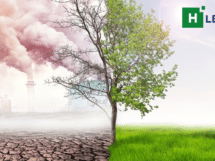Accelerating climate change across the world is now disrupting the pattern of seasons in the Himalayan Valley
March this year was the warmest in Kashmir Valley in the last 131 years. Srinagar recorded a maximum temperature of 27.6°C in the month, the highest since the data began to be recorded in 1891, according to the local meteorological department. Such a sudden rise in temperature took people by surprise. March signals the onset of spring in Kashmir but in reality, it is the extension of the harsh winter. The month sees recurrent vernal showers and sometimes snow too. People, as a result, continue to wear warm clothing and use heating gadgets, including the traditional potable kangri under their long cloaks called pheran. However, this March’s warmth significantly reduced, if not completely eliminated, the need for heating systems. .
What explains this sudden rise in temperature in one of the world’s coldest regions, and that too during one of its coldest months? Of course, the accelerating climate change across the world is now disrupting the pattern of seasons in Kashmir too. One more example of this is the early blooming of flowers such as narcissus, tulips, daffodils, and hyacinths. By late March, Srinagar’s famous tulip garden, Asia’s largest, was a riot of colour. In normal times, tulips bloom only in April. Ditto with the other flowers, which bloomed two to three weeks ahead of their due time.
The early spring heatwave this year, however, was not confined to Kashmir alone. Large parts of the world witnessed it. India’s average maximum temperature in March was 33.1 °C, or 1.86 °C above the long-term average. The month was also the warmest in Pakistan in at least the past 60 years. A number of stations in the country broke their respective March records.
The situation in China has been no different. In Zhejiang, the country’s south-east province which normally experiences temperatures in the high 20s in July, is in the midst of an unprecedented heatwave, with mercury shooting up to 40°C.
Across Europe, the heatwave is still ongoing and wreaking havoc. France and Greece are battling wildfires. An event summary from the UK’s Met Office shows that the country’s recent extreme heat was far more intense and widespread than previous comparable heatwaves. For the first time in history, the UK temperature soared to 40°C.
The United States too, has found itself reeling from the hot spell. California has witnessed raging wildfires that have destroyed thousands of acres and driven people from their homes. Hospitals have seen an uptick in emergency calls for heat-related illnesses.
Though local factors have contributed to the rise in the temperature, at the root of it all is climate change.
Going forward, heatwaves could become the norm rather than the exception. That is, if the world doesn’t urgently wake up to its causes and address them. Meanwhile, the rise in temperature is taking a grim toll on health. Dizziness, headaches, and fainting are all common symptoms of heat exhaustion. Heat stroke is more severe and requires medical attention.
A study published in One Earth in May 2022 found that, by 2099, rising temperatures may cause people to lose 50 to 58 hours of sleep per person each year, which is equivalent to losing more than a week of sleep every year. The effect will be more visible in cities as the concrete jungle traps the heat, unlike the more thinly settled countryside. The sleep-loss, according to the One Eath study, leads to deteriorating cognitive function and reduces immunity to disease, as well as increased incidence of heart problems, and mental health issues.
Are we ready for this frightening prospect? We have to be as there is no other way out. That is, as long as the world doesn’t wake up and acts in concert to pre-empt the inexorability of climate change
















